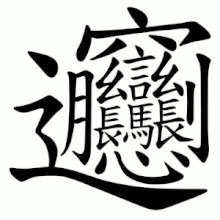Mi Biangbiang: Perbedaan antara revisi
Dibuat dengan menerjemahkan halaman "Biangbiang noodles" |
Tidak ada ringkasan suntingan |
||
| Baris 23: | Baris 23: | ||
Mi Biangbiang langsung dibuat oleh tangan. Awalnya merupakan makanan yang dikonsumsi oleh kalangan orang-orang miskin di pedesaan, tetapi baru-baru ini menjadi terkenal karena karakter unik yang digunakan dalam namanya.<ref>{{Cite web|url=http://www.fuchsiadunlop.com/a-taste-of-xian-in-north-london/|title=A taste of Xi’an in North London {{!}} Fuchsia Dunlop|last=|first=|date=|website=www.fuchsiadunlop.com|language=en|access-date=2019-08-13}}</ref> Mi ini sering dicampur dengan banyak paprika merah pada saat musim dingin di Shaanxi. |
Mi Biangbiang langsung dibuat oleh tangan. Awalnya merupakan makanan yang dikonsumsi oleh kalangan orang-orang miskin di pedesaan, tetapi baru-baru ini menjadi terkenal karena karakter unik yang digunakan dalam namanya.<ref>{{Cite web|url=http://www.fuchsiadunlop.com/a-taste-of-xian-in-north-london/|title=A taste of Xi’an in North London {{!}} Fuchsia Dunlop|last=|first=|date=|website=www.fuchsiadunlop.com|language=en|access-date=2019-08-13}}</ref> Mi ini sering dicampur dengan banyak paprika merah pada saat musim dingin di Shaanxi. |
||
==Aksara han untuk ''biáng''== |
|||
== Catatan == |
|||
{{multiple images| |
|||
| direction = horizontal |
|||
| width = 120 |
|||
| image1 = Biáng (regular script).svg |
|||
| width1 = |
|||
| alt1 = |
|||
| caption1 = The [[Traditional Chinese characters|Traditional character]] for ''biáng'' in calligraphic [[regular script]] |
|||
| image2 = Biáng.svg |
|||
| width2 = |
|||
| alt2 = |
|||
| caption2 = The Traditional character for ''biáng'' in a [[Song typeface|Song]] font |
|||
| image3 = Biang (简体).svg |
|||
| width3 = |
|||
| alt3 = |
|||
| caption3 = The [[Simplified Chinese characters|Simplified character]] for ''biáng'' in a [[Song typeface|Song]] font |
|||
}} |
|||
[[File:SlaterRheaBiang.jpg|thumb|American singer and TV personality in China [[Slater Rhea]] (帅德) writes and explains a ''biáng'' character on Xi'an TV.]] |
|||
Terdiri dari 58 guratan bila ditulis dengan [[Aksara Han tradisional|aksara han tradisional]]<ref group="Note" name="trad-strokes-CN">[[Radikal (Aksara Han)|Radical]] {{lang|zh-Hans|辶}} hanya memiliki tiga guratan (bukan empat) sesuai dengan aturan [[Republik Rakyat Tiongkok|RRT]], sehingga karakter tradisional ditulis dengan hanya 57 guratan di sana, yang tercermin dalam grafik karakter gaya Song dan animasi urutan goresan ke kanan.</ref> dan 42 bila ditulis dengan [[Aksara Han sederhana|aksara han sederhana]]). Aksara ''biáng'' merupakan salah satu aksara paling rumit yang masih digunakan,<ref>{{Cite web|url=http://mentalfloss.com/article/50581/what-most-complex-chinese-character|title=What is the Most Complex Chinese Character?|website=Mental Floss|access-date=2016-06-14}}</ref> meskipun aksara atau karakter tidak ditemukan dalam kamus modern atau bahkan dalam [[kamus Kangxi]]. |
|||
Karakter terdiri dari {{lang|zh-Hant|言}} ("ucapan" terdiri 7 guratan) yang terletak di tengah dan diapit oleh {{lang|zh-Hant|幺}} ("mungil"; 2×3 guratan) di kedua sisi. Di bawahnya, {{lang|zh-Hant|馬}} ("kuda"; 10 guratan) diapit oleh {{lang|zh-Hant|長}} ("tumbuh"; 2×8 guratan). Balok pusat karakter ini sendiri dikelilingi oleh {{lang|zh-Hant|月}} ("bulan"; 4 guratan) dan di sebelah kiri terdapat, {{lang|zh-Hant|心}} ("jantung"; 4 guratan) dan di bawah terdapat{{lang|zh-Hant|刂}} (knife; 2 strokes) to the right. These in turn are surrounded by a second layer of characters, namely {{lang|zh-Hant|穴}} (cave; 5 strokes) on the top and {{lang|zh-Hant|辶}} (walk; 4 strokes<ref group="Note" name="trad-strokes-CN" />) curving around the left and bottom. |
|||
===Phonetic substitution=== |
|||
Neither the [[Traditional Chinese characters|traditional]] nor the [[Simplified Chinese characters|simplified]] Chinese characters for ''biáng'' are yet encoded in [[Unicode]], so there is no standardized way of entering or representing them on computers. However, both traditional and simplified forms have been submitted to the [[Ideographic Rapporteur Group]] for inclusion in [[CJK Unified Ideographs Extension G]].<ref name="auto">[https://www.unicode.org/L2/L2015/15223r-irg-n2091-ext-h-utc.pdf UTC Character Submission for 2015] by the Unicode Consortium</ref> As the characters are not yet encoded, phonetic substitutes like {{zh|labels=no|c=彪彪面}} ({{zh|labels=no|p=biāobiāomiàn}}) or {{zh|labels=no|c=冰冰面}} ({{zh|labels=no|p=bīngbīngmiàn}}) are often used instead. |
|||
The character is described by the following [[Ideographic Description Sequences|ideographic description sequences]] (IDSs):<ref name="irg">See [https://www.unicode.org/reports/tr45/tr45-9.html Unicode Technical Report #45] and [https://www.unicode.org/Public/UNIDATA/USourceData.txt associated data File], UTC-00791. The file references this Wikipedia article as a primary source and a reason for inclusion.</ref> |
|||
<span style="font-size:larger">{{lang|zh-Hant|⿺{辶⿳穴⿰月⿰⿲⿱幺長⿱言馬⿱幺長刂心<nowiki>}</nowiki>}}</span> (tradisional)<br /><span style="font-size:larger">{{lang|zh-Hans|⿺{辶⿳穴⿰月⿰⿲⿱幺长⿱言马⿱幺长刂心<nowiki>}</nowiki>}}</span> (sederhana) |
|||
In Adobe's [[Source Han Sans]] and [[Source Han Serif]] font these IDS sequences do not display as IDS sequences, but display the actual glyphs for the character.<ref>{{Citation |
|||
| url = https://blogs.adobe.com/CCJKType/2017/04/designing-implementing-biang.html |
|||
| title = Designing & Implementing Biáng |
|||
| work = CJK Type Blog |
|||
| publisher = [[Adobe Inc.|Adobe]] |
|||
| accessdate = 2017-12-30 |
|||
| last = Lunde |
|||
| first = Ken |
|||
| date = 2017-04-08 |
|||
| df = mdy-all |
|||
}} |
|||
</ref><ref>{{Citation |
|||
| url = https://raw.githubusercontent.com/adobe-fonts/source-han-sans/release/SourceHanSansReadMe.pdf |
|||
| title = Source Han Sans Version 2.000 |
|||
| publisher = [[Adobe Inc.|Adobe]] |
|||
| accessdate = 2018-11-21 |
|||
| last = Lunde |
|||
| first = Ken |
|||
| date = 2018-11-19 |
|||
| df = mdy-all |
|||
}} |
|||
</ref> |
|||
===Unicode=== |
|||
The character has yet to be added to the [[Unicode Standard]], but the traditional and simplified forms are included in the draft for the [[CJK Unified Ideographs Extension G]] block, which is scheduled for inclusion in the 6th edition of [[ISO/IEC 10646]], tentatively corresponding to Unicode 13.0 (due for release in March 2020).<ref>{{cite web|url=https://www.unicode.org/L2/L2018/18221-n5006-6th-ed-cd-chart.pdf|title=Additional repertoire for ISO/IEC 10646:2017 (6th ed.) CD|publisher=|accessdate=29 August 2018}}</ref><ref>{{cite web|url=https://blogs.adobe.com/CCJKType/2018/06/unicode11.html|last=Lunde|first=Ken|title=Unicode Version 11.0|date=5 June 2018|website=CJK Type Blog|accessdate=29 August 2018}}</ref> |
|||
===Mnemonics{{anchor|Mnemonics}}=== |
|||
[[File:Biáng-order complete.gif|thumb|Animated GIF showing the stroke order of the [[Traditional Chinese characters|Traditional character]] for ''biáng'' according to the mnemonic, not according to the principles of [[stroke order]]. Note that the element 馬 has erroneously been given its [[Japanese language|Japanese]] stroke order.]] |
|||
There are a number of [[mnemonic]]s used by [[Shaanxi]] residents to aid recall of how the character is written. |
|||
One version runs as follows: |
|||
{| |
|||
!width=25%| [[Traditional Chinese|Traditional<br>Chinese]] !!width=25%| [[Simplified Chinese|Simplified<br>Chinese]] !!width=25%| [[Pinyin]] !! English translation |
|||
|- |
|||
| {{lang|zh-Hant|一點上了天}} || {{lang|zh-Hans|一点上了天}} || Yīdiǎn shàngle tiān || Apex rising up to the sky, |
|||
|- |
|||
| {{lang|zh-Hant|黃河兩道彎}} || {{lang|zh-Hans|黄河两道弯}} || Huáng Hé liǎng dào wān || Over Two bends by [[Yellow River]]'s side. |
|||
|- |
|||
| {{lang|zh-Hant|八字大張口}} || {{lang|zh-Hans|八字大张口}} || Bāzì dà zhāngkǒu || Character "Eight"'s ({{lang|zh|八}}) opening wide, |
|||
|- |
|||
| {{lang|zh-Hant|言字往進走}} || {{lang|zh-Hans|言字往进走}} || Yán zì wǎng jìn zǒu || "Speech" ({{lang|zh|言}}) enters inside. |
|||
|- |
|||
| {{lang|zh-Hant|你一扭 我一扭}} || {{lang|zh-Hans|你一扭 我一扭}} || Nǐ yī niǔ, wǒ yī niǔ || You twist, I twist too, ({{lang|zh|幺}} 'tiny') |
|||
|- |
|||
| {{lang|zh-Hant|你一長 我一長}} || {{lang|zh-Hans|你一长 我一长}} || Nǐ yī zhǎng, wǒ yī zhǎng || you grow, I grow ({{lang|zh|長}}) with you, |
|||
|- |
|||
| {{lang|zh-Hant|當中加個馬大王}} || {{lang|zh-Hans|当中加个马大王}} || Dāngzhōng jiā gè mǎ dàwáng || Inside, a horse ({{lang|zh|馬}}) king will rule. |
|||
|- |
|||
| {{lang|zh-Hant|心字底}} || {{lang|zh-Hans|心字底}} || Xīn zì dǐ || "Heart" ({{lang|zh|心}}) down below, |
|||
|- |
|||
| {{lang|zh-Hant|月字旁}} || {{lang|zh-Hans|月字旁}} || Yuè zì páng || "Moon" ({{lang|zh|月}}) by the side, |
|||
|- |
|||
| {{lang|zh-Hant|留個釣搭掛麻糖}} || {{lang|zh-Hans|留个钓搭挂麻糖}} || Liú ge diào dā guà má tang || Leave a hook ({{lang|zh|刂}} 'knife') for Matang (Mahua, Fried Dough Twist) to hang low, |
|||
|- |
|||
| {{lang|zh-Hant|坐著車車逛咸陽}} || {{lang|zh-Hans|坐着车车逛咸阳}} || Zuòzhe chēchē guàng Xiányáng || On our carriage, to [[Xianyang]] we'll ride (radical: {{lang|zh|辶}} 'walk'). |
|||
|} |
|||
Note that the first two lines probably refer to the character {{lang|zh|宀}} (roof), building it up systematically as a point and a line (river) with two bends. |
|||
===Origin of the character=== |
|||
[[File:BiangBiangChaiJiaShiZiLu.jpg|thumb|right|A [[Xi'an]] biangbiangmian restaurant. The Traditional character for ''biáng'' is combined with the Simplified character for ''miàn''.|pra=Special:FilePath/BiangBiangChaiJiaShiZiLu.jpg]] |
|||
The origins of the biangbiang noodles and the character ''biáng'' are unclear. In one version of the story, the character ''biáng'' was invented by the [[Qin Dynasty]] Premier [[Li Si]]. However, since the character is not found in the ''[[Kangxi Dictionary]]'', it may have been created much later than the time of Li Si. Similar characters were found used by [[Tiandihui]]. |
|||
In the 2007 season of the [[TVB]] show ''The Web'' ({{zh|labels=no|c=[[:zh:一網打盡|一網打盡]]}}), the show's producers tried to find the origin of the character by contacting university professors, but they could not verify the Li Si story or the origin of the character. It was concluded that the character was invented by a noodle shop.{{clarify|July 20111|date=July 2011}} |
|||
One theory is that there was no such character or meaning for this word in the beginning, and the word actually came [[onomatopoeia|from the sound]] people make from chewing the noodles, "biang biang biang". |
|||
A legend about a student fabricating a character for the noodle to get out of a biangbiang noodle bill also is a commonly believed theory about the origin of the character.<ref>{{Cite web|url=http://www.chinasimplified.com/2014/02/28/biang/|title=The Hardest Chinese Character |last=Beck|first=Stewart Lee|access-date=2016-06-14}}</ref> |
|||
According to an article on ''[[China Daily]]'', the word "biang" actually refers to the sound made by the chef when he creates the noodles by pulling the dough and slapping it on the table.<ref>{{cite web|work=China Daily |title=Biangbiang Shaanxi street food |url=http://www.chinadaily.com.cn/food/2012-11/18/content_15939056.htm|accessdate=19 November 2012}}</ref> |
|||
===Variants=== |
|||
[[File:Biang biang noodles.jpg|thumb|''Biángbiángmiàn'' in Traditional characters. With exception of the fourth and fifth strokes, the variant of ''biáng'' used is the same as the third variant on the list.]] |
|||
Fifteen variants of the Traditional character for ''biáng'', having between 56 and 70<ref group="Note">[[Radikal (Aksara Han)|Radical]] {{lang|zh-Hans|辶}} hanya memiliki tiga guratan (bukan empat) sesuai dengan aturan [[Republik Rakyat Tiongkok|RRT]], sehingga varian karakter dengan 70 guratan hanya ditulis dengan 69 guratan di sana, yang ditampilkan dalam karakter di bawah ini.</ref> strokes: |
|||
[[File:Biáng.svg|120px]] [[File:Biáng-v1.svg|120px]] [[File:Biáng-v13.svg|120px]] [[File:Biáng-v10.svg|120px]] [[File:Biáng-v12.svg|120px]] [[File:Biáng-v11.svg|120px]] [[File:Biáng-v4.svg|120px]] [[File:Biáng-v5.svg|120px]] [[File:Biáng-v14.svg|120px]] [[File:Biáng-v2.svg|120px]] [[File:Biáng-v6.svg|120px]] [[File:Biáng-v7.svg|120px]] [[File:Biáng-v8.svg|120px]] [[File:Biáng-v9.svg|120px]] [[File:Biáng-v3.svg|120px]] |
|||
==Notes== |
|||
{{Reflist|group="Note"}} |
{{Reflist|group="Note"}} |
||
Revisi per 13 Agustus 2019 08.52
| Mi Biangbiang | |
|---|---|
 | |
| Nama lain | Yóupō Chěmiàn |
| Tempat asal | Tiongkok |
| Daerah | Shaanxi |
| Mi Biangbiang | |||||||||||||||
|---|---|---|---|---|---|---|---|---|---|---|---|---|---|---|---|
| Hanzi tradisional: |   麵 麵
| ||||||||||||||
| Hanzi sederhana: |   面 面
| ||||||||||||||
| Pinyin: | biángbiángmiàn | ||||||||||||||
| |||||||||||||||
| nama alternatif | |||||||||||||||
| Hanzi tradisional: | 油潑扯麵 | ||||||||||||||
| Hanzi sederhana: | 油泼扯面 | ||||||||||||||
| |||||||||||||||
Mi Biangbiang, dengan nama alternatif yang dikenal sebagai Youpo Chemian dalam bahasa Mandarin, adalah jenis mi populer di Provinsi Shaanxi, Tiongkok. Mie ini disebut-sebut sebagai salah satu dari "delapan hal yang ajaib dan aneh dari Shaanxi" (陕西八大怪) dan digambarkan sebagai seperti mi yang berbentuk ikat pinggang, karena sangat tebal dan panjang.
Mi Biangbiang langsung dibuat oleh tangan. Awalnya merupakan makanan yang dikonsumsi oleh kalangan orang-orang miskin di pedesaan, tetapi baru-baru ini menjadi terkenal karena karakter unik yang digunakan dalam namanya.[1] Mi ini sering dicampur dengan banyak paprika merah pada saat musim dingin di Shaanxi.
Aksara han untuk biáng

Terdiri dari 58 guratan bila ditulis dengan aksara han tradisional[Note 1] dan 42 bila ditulis dengan aksara han sederhana). Aksara biáng merupakan salah satu aksara paling rumit yang masih digunakan,[2] meskipun aksara atau karakter tidak ditemukan dalam kamus modern atau bahkan dalam kamus Kangxi.
Karakter terdiri dari 言 ("ucapan" terdiri 7 guratan) yang terletak di tengah dan diapit oleh 幺 ("mungil"; 2×3 guratan) di kedua sisi. Di bawahnya, 馬 ("kuda"; 10 guratan) diapit oleh 長 ("tumbuh"; 2×8 guratan). Balok pusat karakter ini sendiri dikelilingi oleh 月 ("bulan"; 4 guratan) dan di sebelah kiri terdapat, 心 ("jantung"; 4 guratan) dan di bawah terdapat刂 (knife; 2 strokes) to the right. These in turn are surrounded by a second layer of characters, namely 穴 (cave; 5 strokes) on the top and 辶 (walk; 4 strokes[Note 1]) curving around the left and bottom.
Phonetic substitution
Neither the traditional nor the simplified Chinese characters for biáng are yet encoded in Unicode, so there is no standardized way of entering or representing them on computers. However, both traditional and simplified forms have been submitted to the Ideographic Rapporteur Group for inclusion in CJK Unified Ideographs Extension G.[3] As the characters are not yet encoded, phonetic substitutes like 彪彪面 (biāobiāomiàn) or 冰冰面 (bīngbīngmiàn) are often used instead.
The character is described by the following ideographic description sequences (IDSs):[4]
⿺{辶⿳穴⿰月⿰⿲⿱幺長⿱言馬⿱幺長刂心} (tradisional)
⿺{辶⿳穴⿰月⿰⿲⿱幺长⿱言马⿱幺长刂心} (sederhana)
In Adobe's Source Han Sans and Source Han Serif font these IDS sequences do not display as IDS sequences, but display the actual glyphs for the character.[5][6]
Unicode
The character has yet to be added to the Unicode Standard, but the traditional and simplified forms are included in the draft for the CJK Unified Ideographs Extension G block, which is scheduled for inclusion in the 6th edition of ISO/IEC 10646, tentatively corresponding to Unicode 13.0 (due for release in March 2020).[7][8]
Mnemonics

There are a number of mnemonics used by Shaanxi residents to aid recall of how the character is written.
One version runs as follows:
| Traditional Chinese |
Simplified Chinese |
Pinyin | English translation |
|---|---|---|---|
| 一點上了天 | 一点上了天 | Yīdiǎn shàngle tiān | Apex rising up to the sky, |
| 黃河兩道彎 | 黄河两道弯 | Huáng Hé liǎng dào wān | Over Two bends by Yellow River's side. |
| 八字大張口 | 八字大张口 | Bāzì dà zhāngkǒu | Character "Eight"'s (八) opening wide, |
| 言字往進走 | 言字往进走 | Yán zì wǎng jìn zǒu | "Speech" (言) enters inside. |
| 你一扭 我一扭 | 你一扭 我一扭 | Nǐ yī niǔ, wǒ yī niǔ | You twist, I twist too, (幺 'tiny') |
| 你一長 我一長 | 你一长 我一长 | Nǐ yī zhǎng, wǒ yī zhǎng | you grow, I grow (長) with you, |
| 當中加個馬大王 | 当中加个马大王 | Dāngzhōng jiā gè mǎ dàwáng | Inside, a horse (馬) king will rule. |
| 心字底 | 心字底 | Xīn zì dǐ | "Heart" (心) down below, |
| 月字旁 | 月字旁 | Yuè zì páng | "Moon" (月) by the side, |
| 留個釣搭掛麻糖 | 留个钓搭挂麻糖 | Liú ge diào dā guà má tang | Leave a hook (刂 'knife') for Matang (Mahua, Fried Dough Twist) to hang low, |
| 坐著車車逛咸陽 | 坐着车车逛咸阳 | Zuòzhe chēchē guàng Xiányáng | On our carriage, to Xianyang we'll ride (radical: 辶 'walk'). |
Note that the first two lines probably refer to the character 宀 (roof), building it up systematically as a point and a line (river) with two bends.
Origin of the character

The origins of the biangbiang noodles and the character biáng are unclear. In one version of the story, the character biáng was invented by the Qin Dynasty Premier Li Si. However, since the character is not found in the Kangxi Dictionary, it may have been created much later than the time of Li Si. Similar characters were found used by Tiandihui.
In the 2007 season of the TVB show The Web (一網打盡), the show's producers tried to find the origin of the character by contacting university professors, but they could not verify the Li Si story or the origin of the character. It was concluded that the character was invented by a noodle shop.[butuh klarifikasi]
One theory is that there was no such character or meaning for this word in the beginning, and the word actually came from the sound people make from chewing the noodles, "biang biang biang".
A legend about a student fabricating a character for the noodle to get out of a biangbiang noodle bill also is a commonly believed theory about the origin of the character.[9]
According to an article on China Daily, the word "biang" actually refers to the sound made by the chef when he creates the noodles by pulling the dough and slapping it on the table.[10]
Variants

Fifteen variants of the Traditional character for biáng, having between 56 and 70[Note 2] strokes:
Notes
- ^ a b Radical 辶 hanya memiliki tiga guratan (bukan empat) sesuai dengan aturan RRT, sehingga karakter tradisional ditulis dengan hanya 57 guratan di sana, yang tercermin dalam grafik karakter gaya Song dan animasi urutan goresan ke kanan.
- ^ Radical 辶 hanya memiliki tiga guratan (bukan empat) sesuai dengan aturan RRT, sehingga varian karakter dengan 70 guratan hanya ditulis dengan 69 guratan di sana, yang ditampilkan dalam karakter di bawah ini.
Referensi
- ^ "A taste of Xi'an in North London | Fuchsia Dunlop". www.fuchsiadunlop.com (dalam bahasa Inggris). Diakses tanggal 2019-08-13.
- ^ "What is the Most Complex Chinese Character?". Mental Floss. Diakses tanggal 2016-06-14.
- ^ UTC Character Submission for 2015 by the Unicode Consortium
- ^ See Unicode Technical Report #45 and associated data File, UTC-00791. The file references this Wikipedia article as a primary source and a reason for inclusion.
- ^ Lunde, Ken (April 8, 2017), "Designing & Implementing Biáng", CJK Type Blog, Adobe, diakses tanggal December 30, 2017
- ^ Lunde, Ken (November 19, 2018), Source Han Sans Version 2.000 (PDF), Adobe, diakses tanggal November 21, 2018
- ^ "Additional repertoire for ISO/IEC 10646:2017 (6th ed.) CD" (PDF). Diakses tanggal 29 August 2018.
- ^ Lunde, Ken (5 June 2018). "Unicode Version 11.0". CJK Type Blog. Diakses tanggal 29 August 2018.
- ^ Beck, Stewart Lee. "The Hardest Chinese Character". Diakses tanggal 2016-06-14.
- ^ "Biangbiang Shaanxi street food". China Daily. Diakses tanggal 19 November 2012.
Pranala luar
- (Tionghoa) Diskusi Forum CCTV tentang Karakter Biáng
- Posting blog oleh Dan Washburn di biangbiang mie
- (Tionghoa) Penulisan CCTV tentang sepuluh keajaiban aneh Shaanxi
- Gambar tanda Cina dengan karakter biang [1] [2]



















